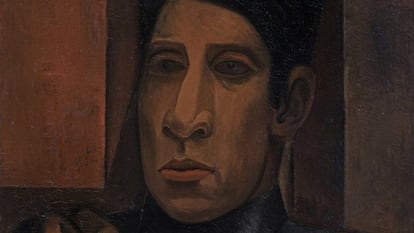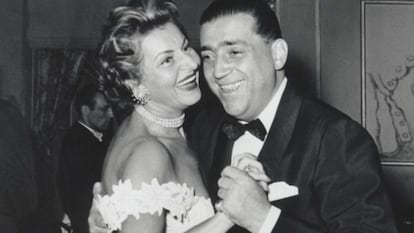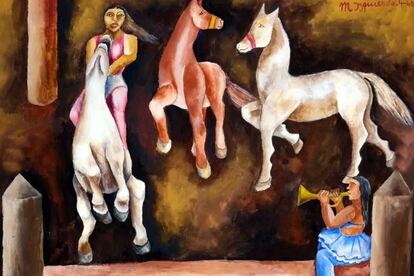Somewhere, one of the most important collections of Mexican art of the 20th century lies hidden. The treasure is made up of paintings by Frida Kahlo, Diego Rivera, David Alfaro Siqueiros, María Izquierdo, Rufino Tamayo, Carlos Orozco, Juan Soriano and Gunther Gerszo, among other great artists. It is called the Gelman collection after its creators, Jacques and Natasha Gelman, great patrons of the arts who amassed a large fortune during the Golden Age of Mexican Cinema. After the couple’s death, the collection passed into the hands of an executor and was exhibited around the world: London, New York, Madrid… until in 2008, after a complicated legal battle, all traces of it were lost. The museum where it was exhibited closed and no one heard from the paintings again, until a few days ago, when an auction at Sotheby’s set off all the alarms.
The catalogue of more than 30 artworks included Siqueiros por Siqueiros (1939), a self-portrait by David Alfaro Siqueiros; Caballos en el circo (1940) by María Izquierdo and Paisaje arcaico (1956), by Gunther Gerzso, which went on sale for hundreds of thousands of dollars. Some of these artists, however, have been designated a national artistic asset and their works are prohibited from leaving Mexico. Upon learning of the auction, the National Institute of Fine Arts and Literature (INBAL) blocked the sale of the painting by María Izquierdo and urged Sotheby’s to comply with the legal provisions applicable in Mexico and the United States. The rest of the works in the catalogue were sold. “Based on information published by Sotheby’s, it is estimated that part of the collection is in the United States, except for the work Siqueiros por Siqueiros, which is located in Mexico. There is no information on the rest of the items,” INBAL told this newspaper. Mexican authorities also acknowledge that they do not know what condition most of the Gelman collection, made up of some 300 works, is currently in, or even where it is.

The case has reopened a debate in the country about the protection of Mexico’s heritage and the cultural loss entailed by the sale of such a valuable collection, valued a few years ago at $200 million. “Natasha and Jacques Gelman’s last wish was for the works to remain in Mexico, as part of a museographic discourse. It was one of the most important collections of modern art that we had in this country,” says the cultural journalist Adriana Malvido, who has followed the case for several decades. “The value of the collection cannot be understood without assessing Jacques Gelman’s role as a collector,” explains the art historian James Oles. “He and his wife were authentic patrons who not only bought works, but also promoted the careers of several artists. Among them, Frida Kahlo and Diego Rivera,” he adds.
The Gelman legacy
Jacques Gelman, born in Saint Petersburg in 1909, arrived in Mexico in 1938, fleeing the war in Europe and wishing to make a career in the film industry. In Paris he had worked for the Pathé studios, and in Mexico he founded the company POSA Films with a then-unknown individual named Mario Moreno, who would later be known for his famous onscreen character Cantinflas. Together they recorded many of the most famous films starring the Mexican actor, which catapulted them into the world of cinema. In 1941 he married Natasha Zahalka Krawak, who was of Czech origin. In 1943, Gelman commissioned a painting of his wife from Diego Rivera. It was the first of many. The portrait of Natasha Gelman surrounded by calla lilies is considered the first work that gave rise to one of the most important Mexican art collections of the 20th century. “Beyond its economic value, the Gelman collection is an important representation of Mexico’s artistic identity,” says Alberto Bremermann, an expert in the art market.

Talking about the Gelman collection always arouses the interest of collectors and experts because the couple did not only undertake the task of buying works by artists residing in Mexico. Picasso, Miró, Dalí, Renoir, Matisse, Kandinski, Modigliani — the collection also contained the best of European art. Currently, the European part of the collection is on display in the Museum of Modern Art in New York.
Since the Gelmans’ death, the collection has not had a real owner, although it was managed by an executor, Robert R. Littman, who curated the collection for the many exhibitions it had abroad. After Jacques Gelman’s death, Natasha loaned the Mexican collection for the first time in 1992 to be shown at the Centro Cultural Arte Contemporáneo de Televisa, where Littman was the director. Mrs. Gelman preferred for the paintings to be kept by the private center rather than by the Mexican State. After Natasha Gelman’s death and the closure of the Televisa cultural center in 1998, several museums offered to house the collection. “There were offers for the collection to be exhibited at the Munal, the Museo Dolores Olmedo, the Franz Mayer… but it didn’t end up in any of those,” says Malvido.
The collection traveled to more than 20 countries over the next four years, generating income for Littman to continue expanding it. The Vergel Foundation is listed as the owner of the works auctioned a few days ago at Sotheby’s. This foundation was created by Littman after the death of Natasha Gelman, in order to manage the works and move them around the world. The traveling exhibition generated enough funds to buy new works, including pieces by Francisco Toledo, Graciela Iturbide and Manuel Álvarez Bravo. This newspaper sought an interview with Robert R. Littman, who declined the offer.
A tough legal battle, a half-brother and Cantinflas’ son
In 2004, the collection returned to Mexico to be exhibited at the Centro Cultural Muros, a museum created by the companies Cotsco and Comercial Mexicana in Cuernavaca, Morelos. The idyll would last only a short time. The collection was there for only four years before disappearing. “I remember that many of us went to visit the collection as if we were on a pilgrimage,” says art historian María Minera. In 2006, several lawsuits filed against Littman by Cantinflas’ adopted son, Mario Moreno Ivanova, blew everything up. Moreno Ivanova claimed that part of the works had been bought through the company founded by his father and Gelman and claimed ownership as Cantinflas’ heir. Although a judge dismissed the lawsuit, new actors entered the scene. Distant cousins and Natasha Gelman’s half-siblings also claimed to be the legitimate heirs of the couple.
In 2007, the lawyer Fuentes León and his son, Enrique Fuentes Olvera, bought the inheritance rights from Natasha’s half-brother, Mario Sebastián Krawak, for $20,000 shortly before his death, and sued for their rights to the works. Although a judge granted them ownership, the decision was overturned in court after a years-long legal battle. This lawsuit was joined by that of a distant cousin of Natasha Gelman, Jerry Jung, who also claimed the inheritance in a U.S. court and attacked Littman. The executor decided to stop exhibiting the paintings and put the collection in safekeeping, until now. The case took years to make headway and ended up dying in court.
Private owners, heritage of the nation
In total, the Gelman Collection has several paintings by Frida Kahlo. Diego in my thoughts (1943), Self-portrait with monkeys (1943), The bride frightened at seeing life opened, (1943) and The Love Embrace of the Universe, the Earth (Mexico), Myself, Diego, and Señor Xolotl (1949), are some of the most important. Notable works by Diego Rivera include Calla Lily Vendors (1943), Modest (1937) and Landscape with Cactus (1931). Diego Rivera has been a designated Artistic Monument since 1954, which prevents his works from being permanently taken out of the country.

The same is true of Frida’s work, which has been declared a national monument since 1984; Siqueiros since 1980 and María Izquierdo, since 2003. This means that there are very few paintings by these authors circulating legally on the market, which makes them rare and very valuable. “There are very few works by Frida on the market, that and her life story make her one of the most sought-after artists,” says James Oles. Only works that were already abroad before the declaration can be sold. This week, Sotheby’s put Kahlo creations on sale that do not belong to the Gelman seed collection and that were later acquired by Littman. The drawings are Carma III (1946), The Miscarriage(1932), Masks (Carma I) (1946), Drawing with a Foot (1946) and Collage with Two Flies (1953).
The law does not prevent a private collector from owning the works, but it does require them to keep them in Mexico and to report any movements they make to the authorities. But Mexican art authorities explained to this newspaper that they are unaware about the current condition of the works in the collection since “there is no reason for a physical verification of all the works that are Artistic Monuments, unless requested by the interested party. However, those that have been exhibited in different museums around the world have been certified by INBAL specialists and all of them are in good condition,” a spokespersona for INBAL stated.
Art historian María Minera, however, considers that this is a “regrettable oversight” and criticizes the fact that the authorities are not more “vigilant about where the works are.” “For example, in the previous six-year period, there was a lot of vigilance about what happened to pre-Hispanic pieces, but not so much with modern art. It would not be the first time that important works by Frida Kahlo, for example, show up abroad”, says this specialist, who considers it “very likely” that all of the Gelman collection artworks, including those considered historical monuments, could be abroad.
Last week it also emerged that a few years ago Littman was in talks with the Mexican State to sell the works, but the purchase never materialized. “Actions should have been taken at an institutional level and negotiated, if not the purchase of the entire collection, at least of some pieces,” says the attorney Bremermann. Gerardo Estrada, director of INBAL between 1992 and 2000, pointed out in a recent interview with the newspaper Reforma the lack of “interest and vision on the part of the State” to preserve this heritage within its borders. “The works in the Gelman Collection are part of the heritage of a private individual. INBAL will continue to carry out the actions that are its responsibility based on the regulatory provisions on the matter, such as issuing temporary export, reproduction, and exhibition permits and providing technical advice on conservation and restoration,” the Institute responded to the question about the actions it will take in light of the latest events.
The outlook for culture in Mexico, however, is not at all encouraging. According to the projected 2025 national budget, the Ministry of Culture will have 30% less public funding and there will be cuts in all departments, including the Institute of Fine Arts and Literature.
Sign up for our weekly newsletter to get more English-language news coverage from EL PAÍS USA Edition

